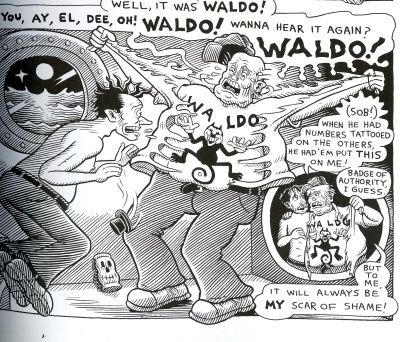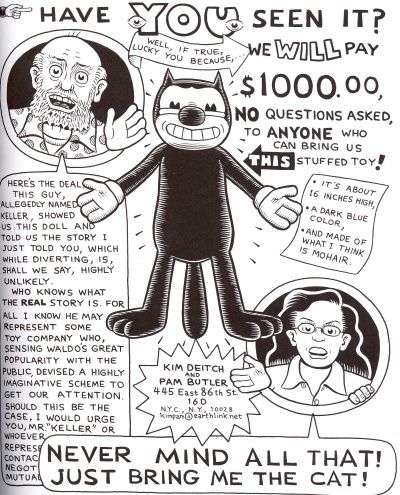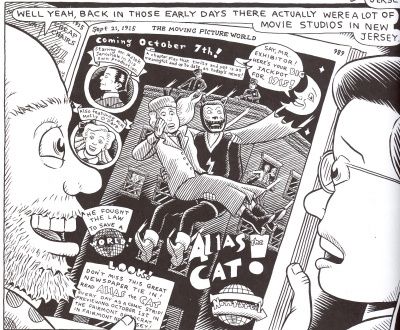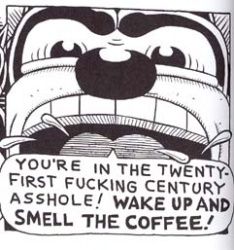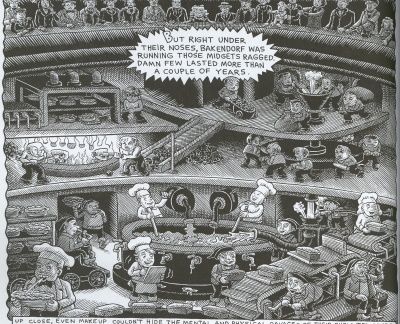Part one: Introduction
Time: Wednesday: April 18, 2007. 3-ish.
Place: Daydreams Comic Shop In Iowa City, Iowa
MarkAndrew: I'd like Alias the Cat, please. I... er... don't see it on the shelf. You (slight quiver) DO have Alias the Cat, right.
Comic Store Guy: We don't have it.
MarkAndrew: So... you didn't get any copies? I know it's out today. I saw it listed on the internet!
Comic Shop Guy: Oh. It came out. We just sold our last one.
MarkAndrew: DUDE! It's Wednesday! It's EARLY!
Comic Shop Guy: Nope. Sorry. You just missed it.
Pause.
Freeze-Frame.
Close-Up on MarkAndrew.
A single tear runs down his face.
Camera pulls back, and we can see the whole shop again.
Comic Shop Guy: ... Actually, wait. Lemme go look in the back.
.
.
.
.
.
Time passes
.
.
.
.
Comic Shop Guy: (Returns) HA! I stole this from my bosses pile! That'll teach him not to pick up his books!
Pause.
Close up on the outside of the shop. MarkAndrew leaves the store humming slightly to himself. Something clinks beneath his shoe as he passes. He pauses, looks down, and is promptly run over by a large green ostrich driving a monster truck.
And that, folks, is the Alias the Cat experience. I'm still mulling over and digesting the book, but that's it in a nutshell. PART of it in a nutshell. It's an autobiographical comic that... just.... stops being autobiography at some point. Although I'm still not sure where. It's a PARODY of an autobiographical comic, it's a superhero comic, it's a chunk of Kim Deitch continuity, with subtle ties to all his past work, it's an examination of the fine line between fantasy and reality, and it has midgets.
It's also really very good.
But still makes my poor head hurt.
Part 2 - Chapter One Discussed
I'm just gonna spoil the ending of chapter one right now.
Is it true? Were Deitch and his wife offering a thousand schmoleans on a cat doll?
Hell if I know. Hell if you guys know either, judging from your response when I asked last 20 questions.
It FEELS true. This book was originally Three Issues of the Stuff of Dreams mini-series that trickled out of Fantagraphics between 2002 and 2005. I own issue one and the offer was the same there, apparently offered without irony. And here's the thing; There are parts of issue one that feel absolutely real. See, I can buy a dude imagining, say, an eight foot tall metallic time traveling monster made out of thorns. No problem. But I have trouble picturing Deitch imagining that his wife trolling E-bay for "Black Halloween Cats from the 20's and 30's and Old Felix the Cat Toys," or faking his own obsession with old movie stills and prints. Or even if he would imagine it, it would be tough to make his "fantasy wife" feel so real. I spent a summer travellin' around sellin' kid-crafts at flea markets. And his descriptions seem spot on.
On the other hand... the damn cat in the picture above? He's a pre-established fictional character. And a fictional character we've seen in Deitch's stuff before. It's
WALDO!
Waldo's been a re-occurring character in Deitch's stuff for YEARS. Most recently and commercially, he was the main character in Boulevard of Broken Dreams, released from Pantheon a couple years back.
So a little background about the black devil-cat's appropriate. He's.... complicated. He's either the fever-dream of a delusional alcoholic of a kind of trickster demon from hell, albeit a devil with a sentimental streak.
And he's an active character in part one of Alias. While out flea-marketing for cat toys, Deitch and Kim run into a vendor selling a Waldo doll at an exhoribadant price. They later meet up with the vendor at the bar, and most of part one is taken up by a flashback of how the guy had actually MET Waldo.
Who is, like I said, a fictional character. There's a whole big story about bein' stuck on a desert island and an exploding volcano and a factory set up to produce Waldo dolls.
That's when the lines get blurry.
So could it possibly be true? I mean, I met Mickey Mouse when I went to later on I saw him with hiding behind a tool shed with his big ol Styrofoam head in his hands havin' a smoke.
Does the Waldo doll exist even if the story's bogus? Is the story bogus because Deitch invented it, tossing in some details from his own life for authenticity? Or did he actually meet the dude with the Waldo Doll, and HE laid some jive on Deitch and his wife.
This is what Alias the Cat does to you. For the first time in my adult life I'm doubtin' the difference between fantasy and reality. It's honestly creepy.
Part 3, Which is the part about Part 2
But, really, as an old-school Deitch fan I'm... if not used to this kinda thing, at least more prepared for it than a Waldo novice. Deitch's work has ALWAYS dealt with the thin line between "real" and "pretend" and the overlap between' em. His wife probably DOES collect cats, but the Waldo doll's gotta be a fake, right? And, really, does a not-all-that-well-known underground cartoonist have a thousand dollars to spend? No, right?
..... I think.
..... I hope.
...... Jeezus.
Part two begins with Deitch showing us all of the ALMOST Waldo knick-knacks and paraphernalia that he received after making his offer in part one.
There was a hand-puppet and a Waldo Clock and a Chia Waldo and a Waldo Bong that "Came Loaded, too." Also a bizzare "White Waldo," a strange, metallic ghost-cat inscribed with "KKK."
Again. I don't KNOW if this part of the story is true. But I kinda hope it is.
Anyway, I mentioned superheroes in the introduction, and this is the superhero chapter. Like the Waldo doll in chapter one, it's centered around finding two more cat-related objects. An antique cat suit purchased from "one of those "furrie" characters" via E-bay, and a roll of film. (Far as I can tell Furrie's are fans of stuffed animals, some of whom like to dress up in "fur suits." There's a distinctly sexual component to all this.) There's even a website URL www.plushnstuff given for the dude. It would be interesting to know if THIS is a real site, but I honestly haven't had the ... um.. inclination to check. (Especially after reading Chynna Clugston's distinctly gross piece over at Nerve.Com. You can google it if you're curious, but you're probably not that curious.)
Anyway, after receiving this beat-up, well-worn and OLD Cat Suit in the mail, Kim and Pam get curious as to where itt came from. Some lucky diggin' through old papers reveals the origin of the suit; Turns out that the suit was both a movie prop and worn by a real life superhero, or somethin' close to it. (He's the dude we see on the cover.) Deitch spends most of this chapter researching the history of the suit, digging through old papers, simultaneously following a comic strip adaptation of the movie serial Alias the Cat, and also finding strange parallels between the strip and actual events.
We've moved staunchly into fantasy here, (probably. Almost certainly.) still exceptionally true-to-life and believable fantasy, with a bunch of acutely observed details to ground it. Deitch brings a really keen understanding of the early 20th century to bear, slippin' in a concise history of early American cinema without ever dropping the threads of the plot. And the poor Cat-cowled superhero... /but no. I'm trying to keep the backstory spoiler free. I WILL say that "Alias the Cat" applies to more than one character, because while we never SEE Waldo in this chapter, there's a mysterious, off-screen figure handin' out Cat Suits to wanna-be vigilantes...
It's Part 2 that I began to figure out what the book is about.
It's about history. And the importance of STUFF as pieces of history. The Stuff of Dreams is both objects and stories.
Even the KKK Cat has a story, or part of one. The dude with the Fur Suit recites:
"It's homemade but it's old; seemed to be some kind of southern fad judging from others like it I've seen, but whether it's racist or a quirky retort to racism is still an open question..."
Huh. So stories and their attached objects are important, even if we DON'T know them.
And maybe even if they're not technically... true?
Part Four - On Part Three
Now THIS is a relief. Part three detours and veers into obvious fantasy, there's a whole town of midgets hidden somewhere in New Jersey, and Waldo actually shows up as a character in the book,
as neither a flashback or an Alias. Either Deitch is putting us on, or he's gone completely around the bend.
Deitch himeself, well, he argues the latter. The story's pure fantasy, now, but Deitch doesn't want to give up the idea that it MIGHT be true. So he depicts himself as a madman, a lunatic who's been carted off to Bellevue, along with his crazy-ass stories about a talking cat.
But is there a chance he's crazy? Naw. In most of his recent work, including Boulevard of Broken Dreams and Shadowland, Deitch wasn't writing stories so much as creating histories, his stories stretching a hundred years or more and encompassing generations - Think Gabriel Garcia Marquez' Hundred Years of Solitude. Alias works on the same principles, it's a fictional period of history more than a story. Part three see-saws between past and present even faster than did in the previous two, telling the same story from two different ends, sorta. The story that supposedly drove him mad takes place in the last remnants of Bakendor Village, AKA"Midgetville," a whole town formerly populated with, well, midgets that's now almost completely vacant and about to be replaced with
WEISSGARDEN Fully Anti-Terror secured State of the Art Gated Community.
And Deitch is here to watch the abandoned city, supposedly the site of "Alias the Cat's" unhappy adventures, in it's death throws. There's another major plot concerns a hidden cache of munitions built by amoral war profiteers in WW I that tie into a homegrown terrorist attack on the Big Apple today... But all that feels beside the point. You get the sense that the story started before the book did, and will continue after we're gone. For all of Kim Deitch's... or the narrators... or who-the-hell-ever's.... attempts to unearth and connect with history, he ends up being almost completely irrelevant to the overall plot. History just sweeps right over him... Until the end, where he's newly released from the asylum, an' he gives us a wink and a nod, and gets to work drawing, a world he finally - on the last page- confesses is "Half Remebered, Half Imagined."
And, sure, the Stuff Of Dreams is part of it all. There's a cache of terrifying statues carved by the chief architect of Midgetville (and part time mad bomber), there's the whirring, clanking, flashing scale model of WEISGARDEN, and there's the town itself... Midgetville was a tourist attraction, where out-of-towners would come to watch the townies dress up as elves as they worked, but, as Waldo tells us
"BUT RIGHT UNDER THEIR NOSES [Mr.] Beckendorf was running those midgets ragged. Damn few lasted more than a couple of years."
Which is really just another secret history.
There's an ironic contrast here between the poor Midgetvillians being worked to death square in the public eye and the way the book ends with Deitch/the narrator at the drawing table, enthusing that he can recreate the world HIS way,
"A wonderful place, where midgets make bread softer than the pillow you lay your weary head on at night."
It seems that he's playing the lunatic character to the hilt, contrasting Kim-Deitch-as-crazy-narrator , the man who can't deal with reality and needs to escape with the actual Kim Deitch the author, who's telling us that stories are forces beyond the artist's control, and that they can only break off little bits of them?
Or are the narrator and the author the same guy, and this is a kind of sad confession that he feels more at home in dark fantasies than the real world, full of "Greedy fucks, evil politicians, and empty, flag-waving assholes?"
Part Five - the Big Wrap Up
And here we're at the end, and I'm not sure how to make sense of the whole thing. There's a hell of a lotta STUFF going on, on a bunch of different levels.
*Deep Breath*
So...
The folding, spindling, and mutilating of the forth wall is performed with consummate craft, handled, in fact, much better'n I've ever seen done in comics, but all of that is more of a story hook than the focus of the book. You COULD interpret it as a warning that too much knowledge is a way dangerous thing, but I never get the sense that Deitch believes that the sad, secret histories he digs up would be better off unburied.
Or maybe history is the wrong word. We know we're not dealing with"True" and "False" absolutes here. And the tone of the book isn't Crumb-manic or Tomine-depressive or Morrison-ironic winking. There's aclever "Ha! I fooled you!" madness masking a deep sadness, where the superhero doesn't get the girl and ends up... nah. Still don't wanna spoil. But in the here and now, everything turns out more-or-less OK at the end, with even evil ol' Waldo settlin' into a sort of domestic bliss.
Hmm. Yeah, what about Waldo? He's not around as much here as he is in much of Deitch's other stuff, but it's hard not to see parallels between his character and the work as a whole. His basic workin'-class-devil personality doesn't change much, but the nature of WHAT he is tends to vary from story to story...
Heck, in chapter three we find Waldo reading Alias the Cat, and dismissing the contents of chapter one as "imaginary." Is history like Waldo, made of the stuff of dreams? If it is, can we do it history.
If I had to boil it down to being "About something" say "Alias the Cat" is about personal mythology, about dealing with a fucked-up life by trying to come into contact with something greater, and about the power of stories to change the world. Every character in "Alias" is busy writing their own stories inside their own head, sometimes love stories, sometimes superhero stories, sometimes visions of a fully anti-terror 21st century gated community. and sometimes any two characters personal narrative will take place in the same reality.. and sometimes they don't.
But even that's probably selling it a little bit short, even.
In the end, Alias demands analysis on the part of the reader, challenging them to confront their own definition of what's real ("real?") and what ain't. but doesn't really offer any answers. What Does it all mean? I dunno. How Much of It is True? Nah Clue. What Alias the Cat does is build a mystery before our eyes, and show us that if we choose to look around us, we're surrounded by the stuff of dreams.

